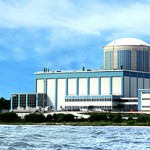 By Peter Galuszka
By Peter Galuszka
When it comes to energy, the 2012 election campaign may present one version of reality but another world – that of cold, hard economics – presents something else. In the process, a number of myths are being shattered.
The most recent news is that Richmond-based Dominion is shutting down its Wisconsin-based Kewaunee Power Station because it is too old and small to continue operating. According to the New York Times, Dominion agreed to contracts for the aging reactor it bought in 2005 to keep providing electricity at certain rates, but now those contracts are expiring and energy prices are so low otherwise that Dominion can’t find a reason to keep it running.
“This decision is based purely on economics,” says Thomas F. Farrell II, Dominion’s president, chief executive and chairman and no stranger to the Virginia political scene.
For a bigger picture look at what is going on, skip over to the op-ed pieces of the Wall Street Journal where energy expert Daniel Yergin lauds the boom in natural gas and oil production. Shale gas is now 10 percent of production. New technology has boosted the production of U.S. oil by 25 percent, resulting in 1.7 million new jobs. This could go up to three million by 2020 and add $62 billion to federal and state revenues this year.
The U.S. is tinkering with the idea of exporting liquefied natural gas whereas just a few years ago, it was widely assumed that we’d always be importing it.
Internationally, this gives the U.S. a hole card more powerful than an aircraft carrier or a drone missile strike. According to Yergin, “The increase in U.S. oil production since 2008 is equivalent to almost 80 percent of what was Iran’s export level before the imposition of sanctions on the Tehran regime. “ In other words, the U.S. has more leverage over mullahs building A-bombs because we need their oil and gas less and less.
The news does raise some troubling questions as well as some stark realities. The Kewaunee nuclear station went into service in 1974, the year I graduated from college. All of the 104 nuclear power stations were in operation or under construction that year. Although maybe five more will be built, the vast majority of the fleet is getting old.
Dominion is planning to maybe build a third unit at North Anna but is taking it slowly, given Fukushima and the August 2011 Virginia earthquake that scrammed its rods. Dominion officials insist they won’t need billions in federal loan guarantees to get financing, but with the gas and oil dynamics being what they are, they can’t help but be a factor when bankers consider loans.
The Republicans in various races have incredibly accused President Obama of dismantling the fossil fuel industry, but when it comes to oil and gas, the opposite seems true.
They claim there’s a “War on Coal” but many of the coal-fired stations face the same problems as the Wisconsin reactor: they are old and they can’t compete, pricewise, with the new reality of American energy.
Bad news for southwest Virginia and the rest of Central Appalachia: coal seams are getting too thin and expensive to mine unless prices go past a certain threshold. New, cheap natural gas has set the price bar too high. When Patriot Coal, which Peabody spun off a few years ago, went bankrupt this summer, it didn’t not blame over-regulation. Nor did Alpha Natural Resources of Bristol, at least publicly, when it announced layoffs last month. (Alpha, however, is a major contributor to the “War on Coal” campaign.)
Yergin goes so far as to describe the boom in gas and oil as “the real stimulus.” Funny how the news never seems to trickle down like tax breaks for the rich are supposed to.


